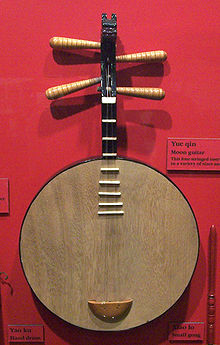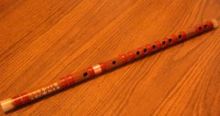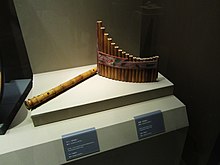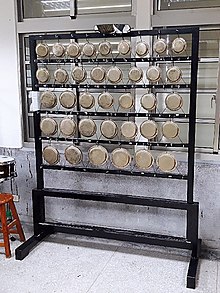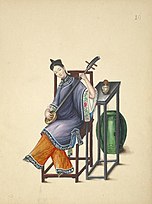| Huqin (胡琴) – family of vertical fiddles |  |
| Erhu (二胡) – two-stringed fiddle |  |
| Zhonghu (中胡) – two-stringed fiddle, lower pitch than an erhu |  |
| Gaohu (高胡) – two-stringed fiddle, higher pitch than an erhu; also called yuehu (粤胡) |  |
| Banhu (板胡) – two-stringed fiddle with a coconut resonator and wooden face, used primarily in northern China |  |
| Jinghu (京胡) – two-stringed fiddle (piccolo erhu), very high pitched, used mainly for Beijing opera |
| Jing erhu (京二胡) – erhu used in Beijing opera |
| Erxian (二弦) – a Chinese bowed string instrument in the huqin family of instruments. It has two strings and is used primarily in Cantonese music, most often in "hard string" chamber ensembles. |  |
| Zhutiqin (竹提琴) – a huqin (胡琴, vertical fiddle) with cylindrical bamboo resonator and paulownia soundboard used in old-style Cantonese opera, both staged (Chinese: gu qiang Yueju, 古腔粤剧) and non-staged (Chinese: gu qiang Yue qu, 古腔粤曲). |
| Yehu (椰胡) – two-stringed fiddle with coconut body, used primarily in Cantonese and Chaozhou music | 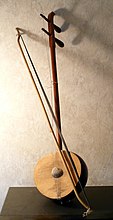 |
| Daguangxian (大广弦) – two-stringed fiddle used in Taiwan and Fujian, primarily by Min Nan and Hakka people; also called datongxian (大筒弦), guangxian (广弦), and daguanxian (大管弦) |
| Datong (大筒) – two-stringed fiddle used in the traditional music of Hunan |
| Kezaixian (壳仔弦) – two-stringed fiddle with coconut body, used in Taiwan opera |
| Liujiaoxian (六角弦) – two-stringed fiddle with hexagonal body, similar to the jing erhu; used primarily in Taiwan |
| Tiexianzai (鐵弦仔) – a two-stringed fiddle with metal amplifying horn at the end of its neck, used in Taiwan; also called guchuixian (鼓吹弦) |
| Niujiaohu (牛角胡) – a yak's horn fiddle used primarily among the Tibetan people |
| Huluhu (simplified Chinese: 葫芦胡; traditional Chinese: 葫盧胡) – two-stringed fiddle with gourd body used by the Zhuang of Guangxi |
| Maguhu (simplified Chinese: 马骨胡; traditional Chinese: 馬骨胡; pinyin: mǎgǔhú) – two-stringed fiddle with horse bone body used by the Zhuang and Buyei peoples of southern China |
| Tuhu (土胡) – two-stringed fiddle used by the Zhuang people of Guangxi |
| Jiaohu (角胡) – two-stringed fiddle used by the Gelao people of Guangxi, as well as the Miao and Dong |
| Liuhu (六胡) – six-stringed fiddle of Mongolian people in Inner Mongolia |
| Sihu (四胡) – four-stringed fiddle with strings tuned in pairs |  |
| Sanhu (三胡) – 3-stringed erhu with an additional bass string; developed in the 1970s |
| Zhuihu (simplified Chinese: 坠胡; traditional Chinese: 墜胡) – two-stringed fiddle with fingerboard |
| Zhuiqin (simplified Chinese: 坠琴; traditional Chinese: 墜琴) – two-stringed fiddle with fingerboard |
| Leiqin (雷琴) – two-stringed fiddle with fingerboard |
| Dihu (低胡) – low pitched two-stringed fiddles in the erhu family, in three sizes: |  |
| Xiaodihu (小低胡) – small dihu, tuned one octave below the erhu |
| Zhongdihu (中低胡) – medium dihu, tuned one octave below the zhonghu |
| Dadihu (大低胡) – large dihu, tuned two octaves below the erhu |
| Dahu (大胡) – another name for the xiaodihu |
| Cizhonghu – another name for the xiaodihu |
| Gehu (革胡) – four-stringed bass instrument, tuned and played like cello |
| Diyingehu (低音革胡) – four-stringed contrabass instrument, tuned and played like double bass |
| Laruan (拉阮) – four-stringed bowed instrument modeled on the cello |  |
| Paqin (琶琴) – bowed pear-shaped lute |
| Dapaqin (大琶琴) – bass paqin |
| Niutuiqin or niubatui (牛腿琴 or 牛巴腿) – two-stringed fiddle used by the Dong people of Guizhou |
| Matouqin (馬頭琴) – (Mongolian: morin khuur) – Mongolian two-stringed "horsehead fiddle" |  |
| Xiqin (奚琴) – ancient prototype of huqin family of instruments |
| Shaoqin (韶琴) – electric huqin |
| Yazheng (simplified Chinese: 轧筝; traditional Chinese: 軋箏) – bowed zither; also called yaqin (simplified Chinese: 轧琴; traditional Chinese: 軋琴) |
| Wenzhenqin (文枕琴) – a zither with 9 strings bowed |
| Zhengni (琤尼) – bowed zither; used by the Zhuang people of Guangxi |
| Ghaychak (艾捷克) – four-stringed bowed instrument used in Uyghur traditional music of Xinjiang; similar to kamancheh[3] | 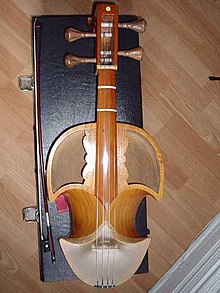 |
| Sataer (萨塔尔 or 萨它尔) – long-necked bowed lute with 13 strings used in Uyghur traditional music of Xinjiang. 1 playing string and 12 sympathetic strings. | 
|
| Khushtar (胡西它尔) – a four-stringed bowed instrument used in Uyghur traditional music of Xinjiang. | 
|
| Qiaoqin (桥琴) – cello-like instrument with snakeskin resonator) from Shenyang | |
| Shenhu (桥琴) – a huqin (2-stringed vertical fiddle with snakeskin-covered resonator) with a distinctive broad, nasal timbre that is used as the primary accompanying huqin (zhu hu, 主胡) in Huju (沪剧), a genre of local Chinese opera (difang xiqu, 地方戏曲) from Shanghai. | |












